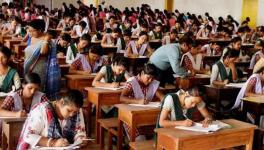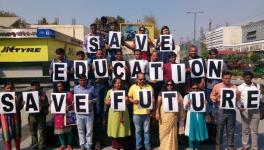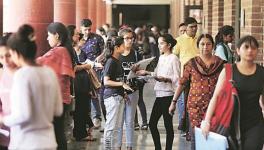Education Budget 2021-22 is Out of Sync with NEP
During the ongoing economic distress, while there is a sharp contraction in the national output, on 1 February 2021, Union Finance Minister Nirmala Sitharaman presented the first Union Budget presented after the COVID-19 pandemic.
India holds the dubious record of the second-highest coronavirus cases after the United States and imposed the harshest lockdown in the world. Consequently, education institutes were compelled to remain shut and they immediately moved to the online mode of delivery.
The abrupt and unplanned move to online education in a country with a deep digital divide not only pushed a large section of the economically-vulnerable students out of the system (thereby aggravating existing educational inequalities) but also resulted in a massive learning loss.
The UNESCO has noted that millions of students from all levels of education in India are on the verge of dropping out of the system. In this context, it was expected that the current budget, for the sake of inclusivity, would provide financial support to the education sector and layout a financial roadmap for achieving the aspirations of National Education Policy (NEP), 2020.
Aggregate allocation to education
The numbers of the education budget indicate the government’s apathy towards one of the sectors worst hit by the pandemic—education. The Ministry of Education received an allocation of Rs. 93,224 crore (BE) in 2021-22 as compared to Rs. 99,300 crore (BE) in 2020-21.
Therefore, with a more than six per cent cut in budgetary allocation from the previous year, the central government has earmarked only 3.5% of the GDP for education, which might further drop in the revised estimates (RE).
Ironically, only a few months back, the government unveiled the NEP 2020, which reiterates the need to allocate six percent of GDP to education. This highlights a worrisome situation and diminishes the hopes of equity and inclusion in education raised by the NEP.
Furthering inequality in school education
Various international and national surveys have documented how the COVID-19 pandemic has unsettled the entire school education system in India. UNESCO has reported that in 2020 around 320 million [32 crores] school-going students lost an academic year almost completely in India.
An already battered school education system suffered an 8.3% cut in allocation from the budget allocation in the previous year (2020-21). Therefore, it is imperative to look at the details of allocation across various categories.
This year the Finance Minister announced the opening of 100 new Sainik Schools. Interestingly, the purpose of setting up Sainik Schools during a pandemic, in the public-private partnership or PPP mode with NGOs and private schools is not clear. Additionally, as laid out in NEP 2020, the government has also set a target of establishing 750 Eklavya Model Residential Schools in tribal areas and strengthening 15,000 schools. However, no funds have been earmarked in the current budget document for the same.
It was expected that the Samagra Shiksha Abhiyan, which is one of the most important centrally-sponsored schemes for school education, would get a higher fund allocation to counter the fallout of the pandemic.
However, this scheme, which subsumes the Sarva Shiksha Abhiyan (SSA), the Rashtriya Madhyamik Shiksha Abhiyan (RMSA), and teacher education, with emphasis on equitable learning outcomes and digitally-enabled classrooms, suffered a 20% fund cut and received only Rs. 31,050 crore (2021-22 BE) as against Rs.38,750 crore (2020-21 BE).
The allocation for the National Means-Cum-Merit Scholarship Scheme, the National Scheme for Incentive to Girl Child for Secondary Education and Operation Digital Board fell by six per cent (from Rs. 373 crores to Rs. 350 crores 2021-22), 99% (from Rs.110 crore to Rs. 1 crore) and 96% (Rs. 25 crores to Rs. 1 crore) respectively from 2020-21 budget estimates.
The fall in the allocation for the National Means-cum-Merit Scholarship Scheme, whose objective is to encourage meritorious students from economically weaker sections to enroll and encourage them to complete their education, departs from the vision of the NEP.
Further, the cut in allocation for the national scheme to incentivise girls from the SC/ST households to enroll and retain them through secondary and higher secondary education will have repercussions on the drop-out rate.
NEP 2020 promotes multilingualism and the power of language in teaching and learning. However, no fund has been allocated in this budget under Appointment of Language Teachers: 100% cut in funds from Rs.100 crore in 2020-21 to nil in 2021-22.
Another component, which is part of the total centrally-sponsored schemes, has been completely deleted, which is the Education Scheme for Madrasas and Minorities. It has been slashed completely from Rs. 200 crores in 2020-21 (BE). The purpose of this scheme was to improve the quality of education imparted in madrasas so that Muslim children can attain better standards of education.
Though budgetary support has been increased for Kendriya Vidyalaya and Navodaya Vidyalaya schools in 2021-22, they constitute a minuscule percentage and are already well-funded. Similarly, despite an upward revision of Rs. 1,900 crore in the revised estimates for 2020-21, this year’s allocation for the Mid-Day Meal Scheme (MDMS) fell by Rs. 1,400 crores compared with the revised estimate.
Now, the BE for MDMS has been slashed in Budget 2021-22 although schools are now gearing to reopen. The allocation is questionable because even during the pandemic—when schools remained closed all year and MDMS was not functioning as normal—the revised estimates for 2020-21 showed an increase in allocation.
By reducing funding in key schemes that are intended to safeguard students at the margins from dropping out brings to the fore the government’s apathy when it comes to addressing access and equality.
Higher education slipping through cracks
One key target of the NEP 2020 is to achieve 50% GER (Gross Enrolment Ratio) in higher education by 2035 and address the unequal access that afflicts the education system. However, in this Budget, higher education received a 2.8% lower allocation as compared to last year.
There is a 28% reduction under the Total Central Sector Schemes—a very important head under the higher education budget—which came down to Rs. 6,069 crore (2021-22 BE) from Rs. 8,406 crore (2020-21 BE).
Research and innovation, considered to be an integral part of any higher education system experienced a substantial decrease to the tune of 23%—from Rs. 307.4 crore (2020-21 BE) to Rs. 237.4 crore (2021-22 BE).
The latest UIS data shows that India, with a meagre 0.7% of GDP spending on research and development, ranks lower than most developed and developing countries.
The cut in funds under this head, as laid out in the current year’s budget, not only reflects the lack of priority for an extremely essential component of higher education, but also a lack of vision in the government to attain an important marker of the Sustainable Development Goals (SDGs), namely, enhancing spending on research and development by 2030.
Education Quality Upgradation and Inclusion Program (EQUIP), which was conceived by the MHRD in 2019 to increase the gross enrolment ratio (GER), improve access and support inclusion, and improve the quality of higher education did not receive any funds in this budget. From Rs. 1,413 crore in 2020-21(BE) the scheme received zero allocation in 2021-22 (BE).
When the challenges of access, quality, and inclusion from socially and economically marginalised groups are looming large in higher education, the dwindling of resources paints a rather discouraging picture and also hints at the government’s intent to privatise the higher education sector.
The NEP 2020 clearly articulates that ICT or information and communication technologies are a key focus of the government in the education sector. Interestingly, while Operation Digital Board received zero fund allocation, the e-learning umbrella under Digital India has received a higher allocation.
Of the increase, the biggest share has gone to Massive Open Online Courses (MOOCs) and to set up virtual classrooms, up from Rs. 75 crores in 2020-21 (BE) to Rs. 200 crores in 2021-22 (BE). However, a disproportionate emphasis on MOOCs, by way of a 167% increase in allocation, requires a cautious assessment of this model.
It is well-known that MOOCs require digital devices and high-speed internet connectivity, which limits their access to individuals from higher-income urban households. The efficacy of MOOCs as a model of learning is also questionable on the ground of poor completion rates (about 90% of those signing up do not complete their course) and poor quality. Further, it would also have huge implications on hiring teachers soon.
Education-related literature also suggests that inadequate public funding has adverse consequences on access to education, which widened during the pandemic. In particular, the shift to online education has exacerbated the existing inequalities, including the effects of the digital divide, manifold. An Oxfam survey says that more than 80% of parents with children enrolled in government schools in Bihar, Chhattisgarh, Jharkhand, Odisha, and Uttar Pradesh reported that education was “not delivered” during the lockdown, as access to a device with an internet connection was a roadblock.
Further, the NEP’s aspiration to reform Early Childhood Education (ECE) is not reflected in the budget document. There is also a need for caution about the politics behind it. For example, why have “World Class Universities” received massive funding while the Scholarship for College and University students did not see any substantial hike from the revised estimates of 2020-21 despite the pandemic?
Thus, it can be argued that the government did not care to make the education system inclusive or resilient through the budget. It did not strive to bring students on the verge of dropping out back into the system. Instead, there is a concerted effort to erode the public nature of education, which jeopardises inclusion and could make the system fragmented and fragile.
A more than six percent reduction in budgetary funds during a pandemic very clearly indicates the government has turned a blind eye to education and intends to make education “atmanirbhar”.
Nivedita Sarkar teaches at Ambedkar University Delhi and Anuneeta Mitra is an independent researcher based in Chicago. The views are personal.
Get the latest reports & analysis with people's perspective on Protests, movements & deep analytical videos, discussions of the current affairs in your Telegram app. Subscribe to NewsClick's Telegram channel & get Real-Time updates on stories, as they get published on our website.
























